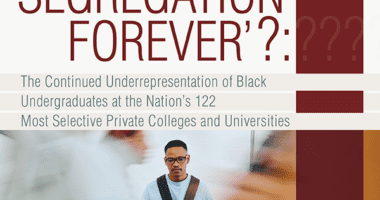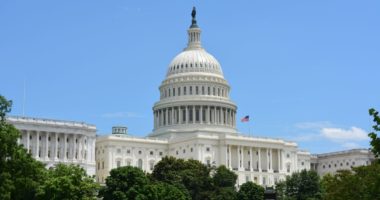Supporting Queer College Students of Color
As we celebrate Pride Month, LGBTQ advocates continue to challenge the actions of the U.S. Department of Education. This advocacy should not be surprising as educational systems in K-12 and higher education have long been criticized for not being a welcoming space for individuals who identify as part of the LGBTQ community. This, of course, must change.
While LGBTQ college students are becoming more visible on campus, they are still marginalized. After all, queer students of color are more likely to feel uncomfortable on campus and encounter higher rates of harassment than their White queer peers. Recognizing that this goes beyond just individual-level actions and behaviors, more attention must be paid to the policies that create these educational environments. Ultimately, to truly be equitable for all groups of students, higher education policy must be intersectional and mindful of students with multiple marginalized identities (e.g., sexuality and race/ethnicity). We must challenge existing approaches to policy that reinforce heterosexism and simultaneously privilege White students.
Using findings from our recent research centered on queer Latino college men as a guide, we outline some key considerations for national, state, and institutional policy that could result in more equitable educational outcomes for queer students of color in higher education.
National Level
Addressing issues related to financial dependency for queer college students is essential to increasing access to higher education. To complete the Free Application for Federal Student Aid (FAFSA), students disclose their dependency status and must include their parents’ financial information unless they are independent. The FAFSA, as it is currently designed, may lead students to conceal their sexuality until they are no longer dependent on family or inadvertently influence parents to use this process as a way to suppress their child’s sexual identity. For example, several queer Latinos in our study noted that they did not “come out” at home because they were financially dependent on their families.
Recommended in a 2011 Dear Colleague Letter, students can communicate with their institution’s financial aid office if they encounter this situation. Currently, students under 24 can only sidestep parental information requirements for FAFSA under special circumstances such as homelessness; so one recommendation is to make cases like queer students being estranged from family for coming out officially a part of these special considerations. Still, these exceptions are completed on a case-by-case basis and require students to divulge their sexuality, which can be emotionally taxing. Therefore, more attention must be given to making the process of obtaining federal aid without support from family manageable, especially for queer students of color. That includes increased training for financial aid administrators and high school guidance counselors to understand these circumstances.
State Level
Intersectional approaches could also inform two areas of state-level educational policy: allocation of funding for institutional resources and outcomes-based funding. Public higher education institutions continue to experience challenges related to the allocation of state funding to promote equity. One notable example involved the Tennessee state legislature, which in 2016, defunded the University of Tennessee’s Office for Diversity and Inclusion, including the LGBTQ Pride Center. Though alumni have since initiated an endowment for the Pride Center, this situation is still troublesome for queer college students, especially those of color. The queer Latino students in our study noted how crucial it was to find individuals who affirmed their sexuality in college, which they typically discovered in LGBTQ centers and queer people of color organizations.
Consequently, state actors must be held accountable for legislation that defunds initiatives for college students who identify with more than one marginalized group. On a related note, recent work by Ed Trust’s Tiffany Jones and other scholars have advanced the need for states to integrate metrics that account for race in performance- or outcomes-based funding (POBF) policies. As state policymakers refine their approach to POBF, they should also consider collecting data about sexual (and gender) identity in order to evaluate similar outcomes for queer students of color. What’s more, queer Latinos in our study emphasized the importance of relationships with faculty and staff from historically underserved communities to help them to succeed. So, another metric that can be integrated into POBF includes counting faculty with marginalized identities.
Institutional Level
Similarly, on an institutional level, queer Latino men in our study discussed how faculty and staff who were racial/ethnic and/or sexual minorities mentored them and shared meaningful advice on how to navigate hostile campus climates. The stories participants shared with us raised questions about the ways faculty and staff are rewarded for their service. Scholars have named the “invisible labor” that teachers of color perform in higher education. These actions, such as mentoring students with multiple marginalized identities, are not necessarily recognized or rewarded by promotion and tenure committees or considered worthwhile for non-tenured faculty.
Moreover, the sheer presence of staff and faculty with marginalized identities, such as faculty of color, at institutions of higher education has long been critiqued. To support queer Latino students, administrators should revisit their hiring and retention practices for diverse faculty (as it relates to identities such as race, sexuality, etc.), as well as how these individuals are compensated for their labor, especially in the promotion and tenure process.
Though not exhaustive, these recommendations for national, state, and institutional-level policy have the potential to substantially increase the success of queer college students of color. When attempting to create equitable educational environments, we must consider students with multiple marginalized identities. As we reach the end of Pride month, the stories shared by the participants in our study remind us and others that the best way to celebrate Pride and our LGBTQ collegians is to continuously advocate for educational spaces that affirm their intersecting identities.
Antonio Duran is a doctoral candidate in the Higher Education and Student Affairs program at The Ohio State University. His research interests include employing intersectional frameworks to center the experiences of queer and transgender students with multiple marginalized identities.
David Pérez II, Ph.D., is an associate professor in the Department of Educational Leadership at Miami University in Oxford, OH. His research agenda centers on fostering student success in higher education.









